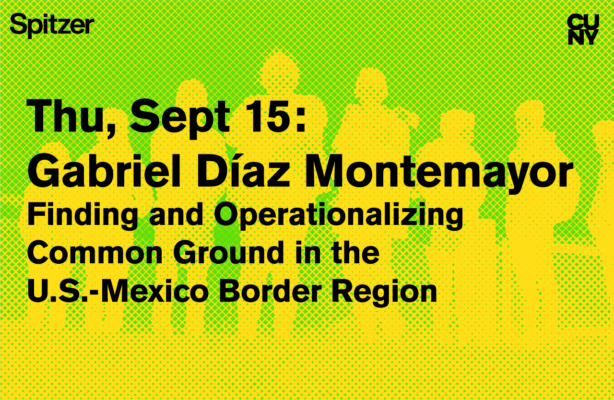News
Gabriel Díaz Montemayor Lecture Recording
This lecture was held in-person as part of the Fall 2022 Sciame Lecture Series, titled “Border Crossings: Architecture and Migration in the Americas.”
Gabriel Díaz Montemayor, ASLA, is an Assistant Dean for Diversity, Equity, and Inclusion and an Associate Professor of Landscape Architecture at the Fay Jones School of Architecture and Design at the University of Arkansas. Gabriel’s studio teaching is focused on multi-scalar and polyvalent research and service-learning projects for the Border Region between the United States and México. Gabriel keeps a part-time practice in urban design and landscape architecture as founding partner of LABor Studio, based in Chihuahua City, México. Gabriel’s research and teaching is also concentrated in the advocacy and development of a landscape architecture specific to Latin American regions.
“Finding and Operationalizing Common Ground in the U.S.-Mexico Border Region”: The United States and Mexico share most of the North American continent. While their relationship is full of asymmetric dimensions and their corresponding booms and busts, both cannot ignore their inescapable ecology found in their shared landscapes. When planning and designing the inhabitation of their common ground, most of the attention is unsurprisingly focused on economic and political infrastructures, while little attention is invested on socio-ecological infrastructures. Typically, the national scale political conversation — or conflict — supersedes the local and community-oriented dialogues, which are much richer, positive, and suggestive. This is unsustainable. This presentation is a proposal to adjust and diversify the understanding of their common ground toward sustainability and resiliency, from the top down and the bottom up. This is to be demonstrated through a series of professional and academic studio-based projects that recognize social, cultural, and economic differences, while revealing shared opportunities and practices. The projects are multi-scalar and polyvalent, ranging from the territorial to the urban to the neighborhood and the site specific. Project locations include “Ambas Nogales” (Spanish for “Both Nogaleses,” one in Arizona, one in Sonora), Hermosillo, Ciudad Juarez, Chihuahua City, and the Lower Rio Grande/Bravo Delta/Valley.
Professor Catherine Seavitt Nordenson will introduce the speaker.
Suggested Reading: From The Ground Up
“Border Crossings: Architecture and Migration” in the Americas presents meditations on the topic of migration from nontraditional, creative, and interdisciplinary perspectives. The distinguished speakers — architects, landscape architects, architecture historians, social historians, a philosopher, an anthropologist, and an attorney — question conventions, especially the conceptualization of migration as linear. They frame migration as a multivalent process, considering the lived realities and material conditions of migration, historically and in the present. Migration in the Americas is more than just the movement and resettlement of bodies, numbers that cross lines and appear/disappear in different places. Migration is not merely (dis)placement, it is also a metamorphosis. Migrants are human beings who are transformed to the core by their movement, and they transform not only their places of departure and arrival, but the entire space that is filled with their journeys.
This lecture series is made possible by the Spitzer Architecture Fund and the generous support of Frank Sciame ’74, CEO of Sciame Construction.


